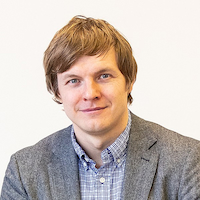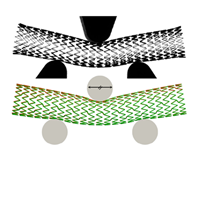events
[Video available!] Severo Ochoa Seminar - "The shifted boundary method for embedded solid mechanics", by Guglielmo Scovazzi
Tuesday, June 29th, 2021. Time: 12 noon
Blending learning: O.C. Zienkiewicz Conference Room, C1 Building, UPC Campus Nord, Barcelona - Link for online session: meet.google.com/qjo-sttx-dgo
ABSTRACT
A new embedded/immersed framework for computational solid mechanics is presented, with the aim of vastly speeding up the cycle of design and analysis in complex geometry. In many problems of interest, the proposed approach bypasses the complexities associated with generation of CAD representations and subsequent body-fitted meshing, since it only requires a relatively simple surface representation of the geometries to be simulated, such as, for example, STL files widely used in computer graphics (i.e., collections of disconnected triangles in three dimensions). Most finite element embedded boundary methods are of difficult implementation, due to the need to perform complex cell cutting operations at boundaries, and the consequences that these operations may have on the overall conditioning of the ensuing algebraic problems. The “shifted boundary method” (SBM) eliminates the need to perform cell cutting. Boundary conditions are imposed on a surrogate discrete boundary, lying on the interior of the true boundary interface. We then construct appropriate field extension operators, with the purpose of preserving accuracy when imposing the boundary conditions. An extensive set of computational experiments in two and three dimensions is included, to demonstrate optimal convergence of the error and robustness in complex geometry simulations.
Abstract References:
[1] Main, A. and Scovazzi, G., 2018. The shifted boundary method for embedded domain computations. Part I: Poisson and Stokes problems. Journal of Computational Physics, 372, pp.972-995.
[2] Li, K., Atallah, N.M., Main, G.A. and Scovazzi, G., 2019. The Shifted Interface Method: A flexible approach to embedded interface computations. International Journal for Numerical Methods in Engineering.
[3] Atallah, N.M, Canuto, C., Scovazzi, G., 2021. The Shifted Boundary Method for Solid Mechanics. Accepted in International Journal for Numerical Methods in Engineering.
SPEAKER CV
 Guglielmo Scovazzi is Professor of Civil & Environmental Engineering and Mechanical Engineering & Materials Science at Duke University. His interests are in the general area of computational mechanics, and specifically in CFD, computational solid mechanics, fluid/structure interaction, computational geomechanics, flow through porous media.
Guglielmo Scovazzi is Professor of Civil & Environmental Engineering and Mechanical Engineering & Materials Science at Duke University. His interests are in the general area of computational mechanics, and specifically in CFD, computational solid mechanics, fluid/structure interaction, computational geomechanics, flow through porous media.
He earned B.S./M.S. Degrees in Aerospace Engineering at Politecnico di Torino in 1998. He received a M.S. in 2001 and a Ph.D. in 2004, both from the Mechanical Engineering Department at Stanford University. Between 2004 and 2012, he held a position as Senior Member of the Technical Staff at Sandia National Laboratories, Albuquerque (New Mexico).
Guglielmo Scovazzi is a recipient of the 2014 Early Career Award from the Office of Science of the US Department Of Energy (ASCR program), and the 2017 Presidential Early Career Award for Scientists and Engineers (PECASE). In February 2018, he was named Kavli Fellow by the National Academy of Sciences and the Kavli Foundation. The Kavli Fellowship acknowledges contributions of U.S. scientists under the age of 45.
He is an associate editor of the Journal of Computational Physics and in the editorial board of the International Journal on Numerical Methods for Fluids. He is a member of the executive board of USACM and a member of SIAM and ASME.





















